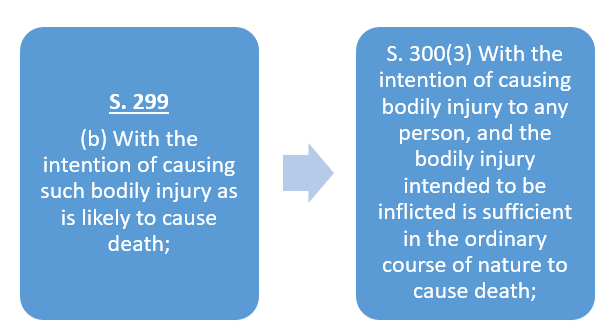Understand the Difference between Culpable Homicide and Murder
- shrey singh
- Jul 7, 2021
- 3 min read
Updated: Jul 31, 2021
Culpable Homicide and Murder
Culpable Homicide is a broader category in which the actus reus is death and mens rea is as mentioned in 3 parts of S. 299. In case of murder also actus reus is death and mens rea is defined under 4 sub-clauses of S. 300.
For any reason to be proved in murder, it has to be proved that it has to be a case under S 299 and then the ingredients of S. 300 has to be seen.Firstly it has to be proved that the case is of culpable homicide and after that by proving additional element which are mentioned under S. 300, murder has to be proved.


Justice Melvill while deciding this case laid down the difference between the two which is summarised in following paragraphs:
S. 299
S 300
A person commits culpable homicide, if the act by which the death is caused is done
(a) With the intention of causing death;
(b) With the intention of causing such bodily injury as is likely to cause death:
(c) With the knowledge that the act is likely to cause death.
Subject to certain exceptions, culpable homicide is murder, if the act by which the death is caused is done
(1) With the intention of causing death;
(2) With the intention of causing such bodily injury as the offender knows to be likely to cause the death of the person to whom the harm is caused;
(3) With the intention of causing bodily injury to any person, and the bodily injury intended to be inflicted is sufficient in the ordinary course of nature to cause death;
(4) With the knowledge that the act is so imminently dangerous that it must in all probability cause death, or such bodily injury as is likely to cause death.
S. 299(a) and S 300(1)
S. 299 (a) and S.300 (1) show that where there is an intention to kill, the offence is always murder.

S.299(b) and S. 300(2)

For S. 300(2), the element of S. 299(b) has to be proved first i.e. intention of causing death.Then the offence is murder, if the offender knows that the particular person injured is likely, either from peculiarity of constitution, or immature age, or other special circumstance, to be killed by an injury which would not ordinarily cause death. The illustration given in the section is the following:
A, knowing that Z is labouring under such a disease that a blow is likely to cause his death, strikes him with intention of causing bodily injury. Z dies in consequence of the blow. A is guilty of murder, although the blow might not have been sufficient in the ordinary course of nature to cause the death of a person in a sound state of health.
S.299(b) and S. 300(3)

The offence is culpable homicide, if the bodily injury intended to be inflicted is likely to cause death; it is murder, if such injury is sufficient in the, ordinary course of nature to cause death. The distinction is fine, but appreciable.It is a question of degree of probability. Practically, it will generally resolve itself into a consideration of the nature of the weapon used. A blow from the fist or a stick on a vital part may be likely to cause death; a wound from a sword in a vital part is sufficient in the ordinary course of nature to cause death.
S.299(c) and S. 300(4)

S. 299 (c) and S.300 (4) is intended to apply to cases in which there is no intention to cause death or bodily injury like Furious driving, firing at a mark near a public road, etc. Whether the offence is culpable homicide or murder, depends upon the degree of risk to human life. If death is a likely result, it is culpable homicide; if it is the most probable re


댓글